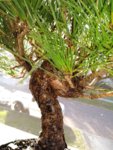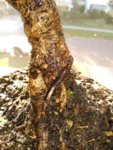Here? You live in northern NEGeorgia.
About the only thing it has in common with Orlando, FL is a time zone.
Science is fundamentally observation, not presumption that all that could be known is already known. A sciency guy, like me for example, might have noted that Adam Levigne (who lives in the environs of Orlando) repots as many of his trees in August as he does this time of year. Yes, they are tropical species. But, I wonder, what qualifies as a tropical tree? Is it only tropical trees? Is it only in Orlando, FL?
Two decades or more ago Vance Wood noted that mugo pines thrived when repotted around August. He lives in Michigan!!!! How can that be? But it works here. in heaven's half-acre, too. Are mugos tropical species? Is is because of the climate? My response was to try repotting a number of trees of varied species and presented the results here on BNut. I did this with zelkova serrata, eastern redbud, cork oak, lodgepole pine, and Douglas fir, repotting in spring versus around August and showed that all these species have this capacity to be repotted in the middle of summer in common with mugos and with whatever Adam Levigne is working on in Orlando.
Your response is not curiosity, acceptance, or anything even similar. You dismiss it all as some magic of my climate. You don't even consider that it might be that I am a horticultural genius. Instead you helicopter in and herald that everything anyone needs to know is known and we should just have a beer. Or. as in this case, that all should be very afraid because climate makes a difference: 0so lives in horticultural heaven. This what I dislike.
Again, apologies for the thread bomb.
@Billskarsgard.
 . Do NOT ever bare root pines! Recent Mirai Live presentation Repotting rootbound nursery stock covers this most well.
. Do NOT ever bare root pines! Recent Mirai Live presentation Repotting rootbound nursery stock covers this most well.




